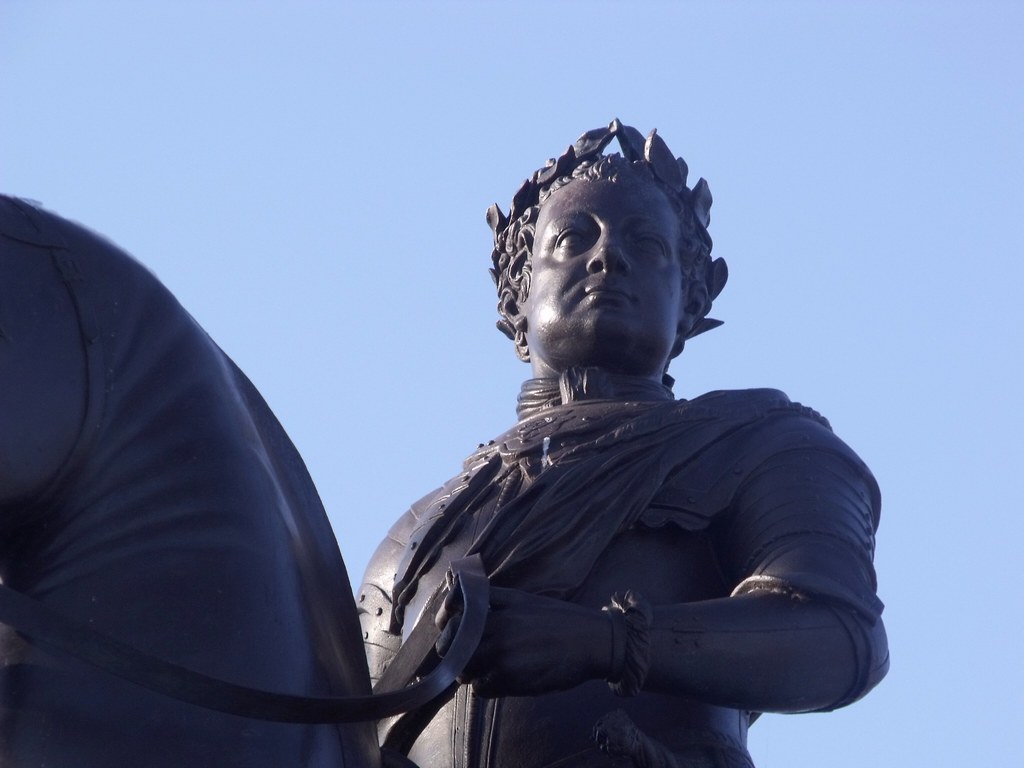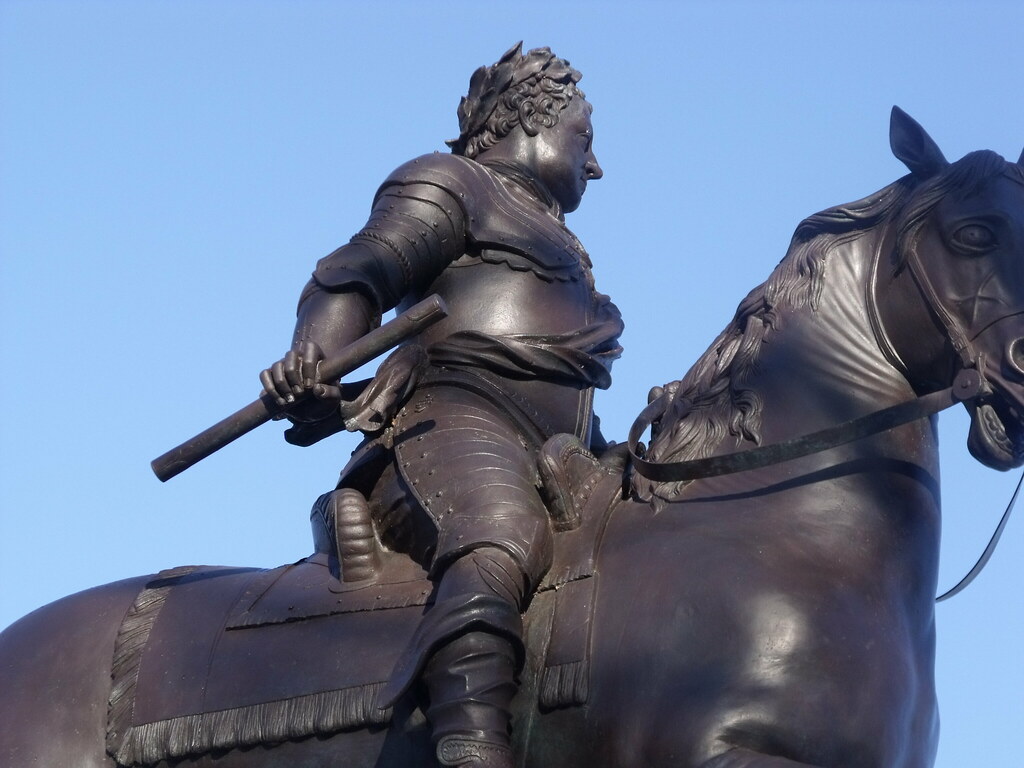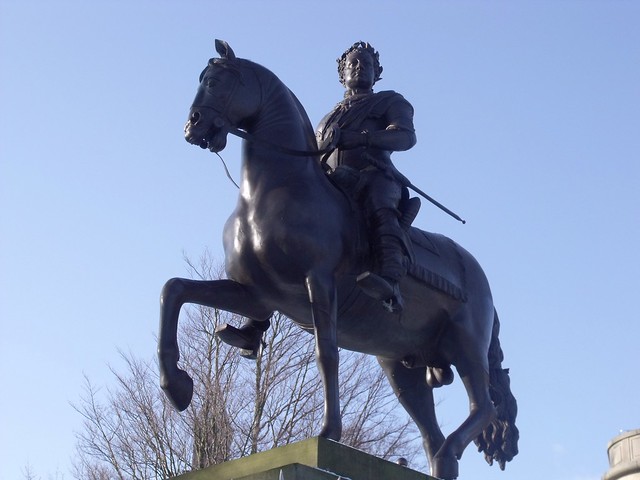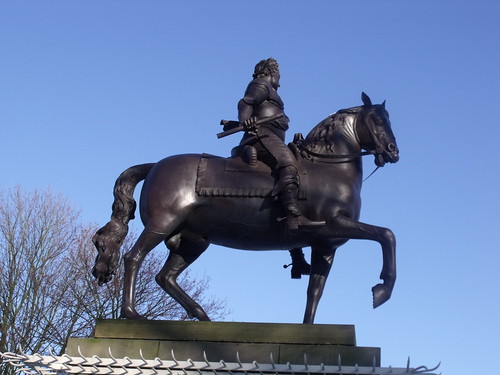The Equestrian Statue of George I (1660 - 1727).
in Modern Armour.
John van Nost.
1717 - 1722.
George I ascended the throne of England in 1714
Formerly on the Essex Bridge (now Gratten), Dublin.
Now at the Barber Institute.
University of Birmingham.






Originally placed on the Essex (now Grattan) bridge, Dublin.
Commissioned by the City of Dublin in 1717.
"
a grateful acknowledgement of the many favours
conferred on this city by his present majesty King George”.
see Nost's Equestrian George I Restored.
by Paul Spencer - Longhurst and Andrew Naylor, Sculpture Journal, Volume II, 1998.
This memorial statue to George I was commissioned by a
committee of the Dublin Assembly in 1717, probably by John van Nost the Elder,
who had made at least five other equestrian statues of him. This work was
unveiled on a pier of Essex (now Gratton) Bridge in Dublin on 1st August 1722
amidst great celebrations.
The Essex Bridge was rebuilt in 1755 and the statue was removed. It first went into storage at what had possibly been Lord Longford's House in Aungier Street and in 1798 was re erected in the grounds of the Dublin Mansion House in Dawson Street where it remained until it was sold.
22 Aungier Street was the home and workshop of John van Nost III. It seems that the statue might have spent a considerable time at the workshop of van Nost III and was almost certainly the modell for the two Irish Equestrian Statues made by John van Nost III the bronze in St Stephens Green and the lead on the bridge at Cork.
For an Excellent study of the historic Aungier Street Area see - https://www.dublincity.ie/sites/default/files/content/YourCouncil/LocalAreaServices/SouthEastArea/SouthEastArea/AungierStreet/Documents/AungerStReport.pdf
After some wrangling it was agreed by the General Purpose Committee of the Corporation of Dublin to dispose of it in September 1937
It was bought by Thomas Bodkin, first director of the Barber Institute, and a former director of the National Gallery of Ireland who had been negotiating with Alfie Byrne the Mayor of Dublin for £500 and installed at The Barber Institute in 1937.
see -
The
construction and destruction of a colonial landscape:
monuments to British monarchs in Dublin
before and after independence by Yvonne Whelan, Journal of Historical Geography 2002.
see - For Brookings map of Dublin and the mapping of Dublin in general see http://eprints.maynoothuniversity.ie/2568/1/Thesis_CD.pdf
Cropped and enlarged from the Engraving by Parr after Joseph Tudor
c.1750, showing the Customs House, Essex Bridge and Statue of George I now at the Barber Institute

A Prospect of the Custom House and Essex Bridge,
Dublin / Prospect von Dublin, bis au der Brücke D'Essex A. L. Wirsing exudit
Norimberg by Adam Ludwig Wirsing (1733 or 1734-1797) .
Copper-plate engraving by A. L. [Adam Ludwig]
Wirsing (1733 or 1734-1797; copied from an image by artist Joseph Tudor,
engraved by Parr that was published in 1753 as No. 4 of a series of Six
Views [of Dublin] with Wirsing’s own alterations and additions
The images above in fact show the rebuilt Essex Bridge of 1755 by George Semple. It had been
originally constructed in 1676 during the Viceroyalty of Arthur Capell, Earl of Essex. - The Equestrian statue was not set up on it and so the image is rather fanciful, this new bridge was based on the new Westminster Bridge although built 7' wider ione of the first Initiatives of the Dublin Wide Streets Commission..
________________________________

Equestrian Statue of George I
Engraving: Dublin Penny Journal Vol.
4, 5th December 1835 p. 184.
For the restoration Equestrian Statue of George I at Stowe see the excellent website of conservator Rupert Harris -
_________________________________

Equestrian Portrait of George I
by John Vanderbank
316 x 240 cms
Vanderbank was born in London; his father was a Huguenot tapestry weaver from Paris, who worked in Holland before coming to England. Vanderbank studied with Kneller and briefly set up his own Academy with Louis Cheron.
According to George Vertue, ‘only intemperance prevented him from being the greatest portraitist of his generation’. This equestrian portrait was painted for a loyal subject (perhaps Richard Bateman, 1705-73) rather than the King, but is clearly influenced by the Dahl portrait of Prince George from the previous reign (OM 382, 405895, then hanging at Windsor) and Van Dyck's 'Charles I' (then in the collection of the Duke of Marlborough, now in the National Gallery). The King is shown mounted on a dun horse, wearing a red jacket, black boots and hat with the Riband and Star of the Order of the Garter and holding up a baton in his right hand. Members of the Household Cavalry can be seen beyond.










Was Van Nosts Equestrian Statue ever displayed in Paradise Circus next to the Town Hall?
ReplyDelete